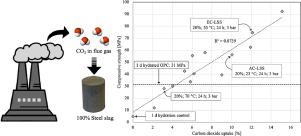Resources, Conservation and Recycling ( IF 11.2 ) Pub Date : 2021-07-30 , DOI: 10.1016/j.resconrec.2021.105819 Shipeng Zhang , Zaid Ghouleh , Jingyi Liu , Yixin Shao

|
The aim of this study is to explore the feasibility of valorization of steelmaking ladle slag into a high-strength cementing material through a carbonation-activation step that uses flue-gas, so that a closed-loop recycling solution can be achieved. Flue-gas (20% CO2) carbonation was carried out at ambient (23°C) and elevated (55°C) temperatures. After 24 h of flue gas carbonation at 55°C, ladle slag compacts achieved an average compressive strength of 74.7 MPa with a CO2 uptake equivalent to 12.1 wt.%. In comparison, conducting carbonation at the ambient temperature recorded lower values for strength and CO2 uptake, and yielded a less refined and more porous microstructure. Nevertheless, carbonated compacts under both ambient and elevated temperatures achieved better strength performances at all testing ages than the hydrated OPC control reference specimens. The CO2 in flue gas precipitated as calcite in the paste matrix regardless of curing temperature; however, the elevated temperature of 55°C was found to additionally promote the precipitation of aragonite crystals. In an environmental impact assessment model that uses conventionally-cured OPC as the industry-standard baseline with global warming potential (GWP) of 1204.4 kg CO2-eq/m3, the alternative use of carbonation-activated ladle slag was found to greatly reduce the overall GWP to a range between 39.2 and 247.5 kg CO2-eq/m3, even when taking the increased curing temperature into consideration. This work presents a possible future scenario where high-strength cementing material could be produced by recycling locally sourced slag, stack-captured flue gas, and waste heat energy from steel plants.
中文翻译:

不同温度烟气碳酸化将钢包渣转化为高强度胶结材料
本研究的目的是探索通过使用烟气的碳化活化步骤将炼钢钢包渣增值为高强度胶结材料的可行性,从而实现闭环回收解决方案。烟道气 (20% CO 2 ) 碳酸化在环境 (23°C) 和升高 (55°C) 温度下进行。在 55°C 下进行 24 小时的烟道气碳酸化后,钢包渣压块的平均抗压强度为 74.7 MPa,CO 2吸收量相当于 12.1 wt.%。相比之下,在环境温度下进行碳酸化记录的强度和 CO 2值较低吸收,并产生更细化和更多孔的微观结构。尽管如此,与水合 OPC 对照参考样品相比,在环境温度和高温下的碳酸压坯在所有测试年龄下都实现了更好的强度性能。无论固化温度如何,烟气中的CO 2 都会以方解石的形式沉淀在膏体基质中;然而,发现 55°C 的高温会额外促进文石晶体的沉淀。在使用常规固化 OPC 作为行业标准基线的环境影响评估模型中,全球变暖潜能值 (GWP) 为 1204.4 kg CO 2 -eq/m 3研究发现,即使考虑到提高的固化温度,碳化活化钢包渣的替代使用也能将总 GWP 大大降低至 39.2 至 247.5 kg CO 2 -eq/m 3之间的范围。这项工作提出了一种可能的未来情景,即通过回收当地来源的矿渣、烟囱捕获的烟气和钢铁厂的废热能来生产高强度胶结材料。











































 京公网安备 11010802027423号
京公网安备 11010802027423号